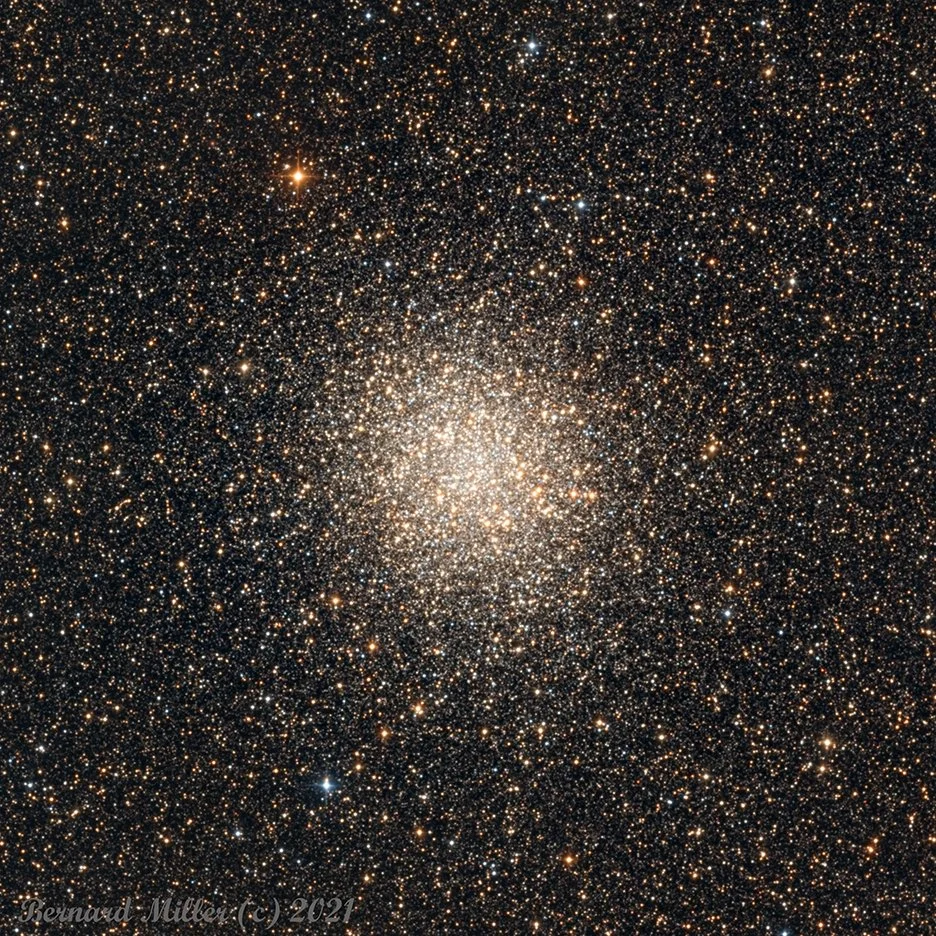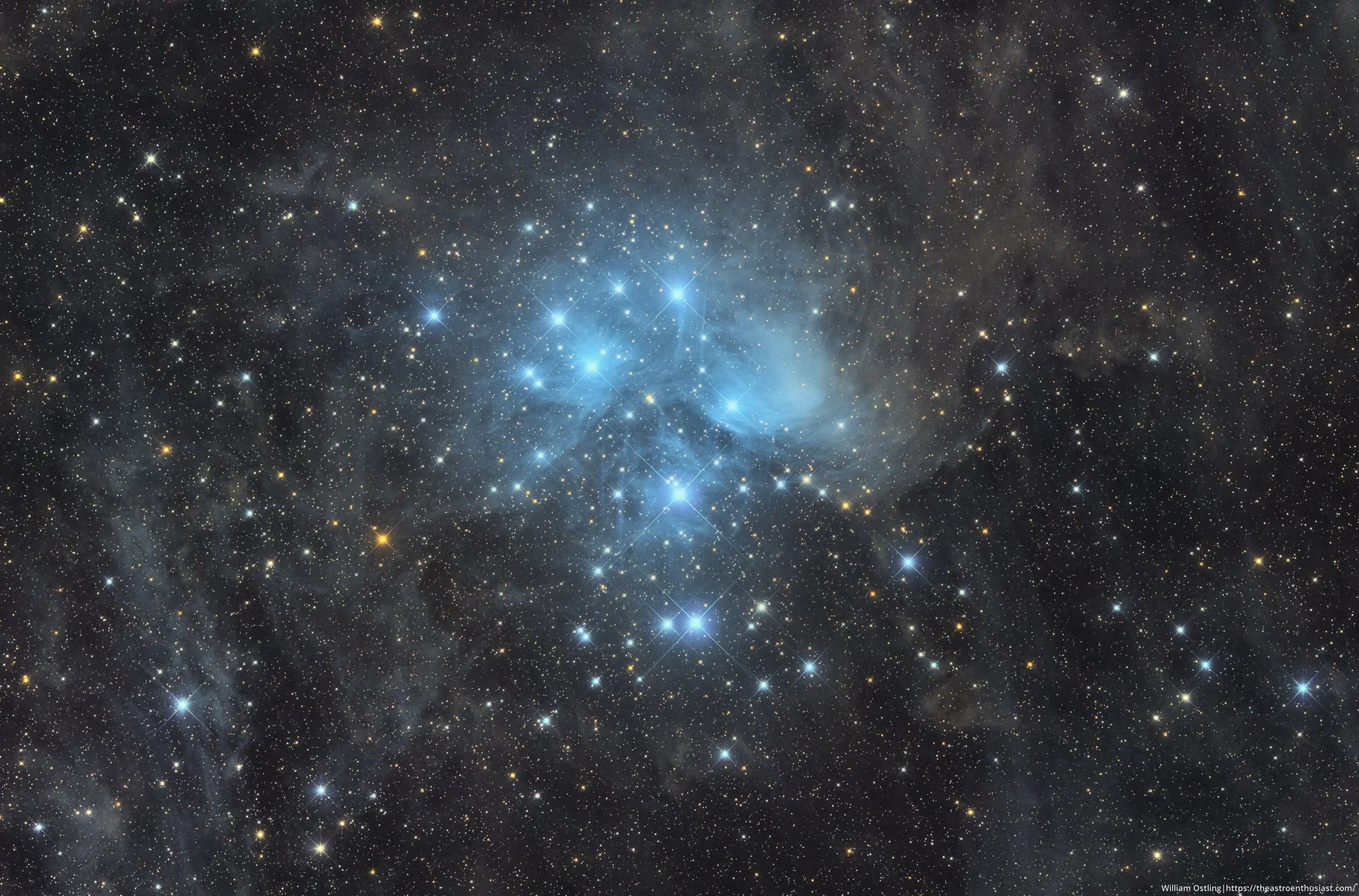
AAPOD2 Image Archives
m92
Image Details
Messier 92 (also known M 92, or NGC 6341) is a globular cluster of stars in the northern constellation of Hercules. It was discovered by Johann Elert Bode in 1777, then published in the Jahrbuch during 1779. It was inadvertently rediscovered by Charles Messier in 1781 and added as the 92nd entry in his catalogue. It is about 26,700 light-years away from the Solar System. It is one of the brighter of its sort in apparent magnitude in the northern hemisphere and in its absolute magnitude in the galaxy, but it is often overlooked by amateur astronomers due to angular proximity to bright cluster Messier 13, about 20% closer. It is visible to the naked eye under very good conditions.
This image taken in September 2021.
L-channel - 60 x 150 sec. bin 1x1;
R-channel - 24 x 150 sec. bin 1x1;
G-channel - 24 x 150 sec. bin 1x1;
B-channel - 24 x 150 sec. bin 1x1.
Total integration time about 05:30 hours.
My setup: Telescope 8" Celestron Schmidt-Cassegrain (SCT) CPC800 GPS (XLT) on the equatorial wedge, focal reducer Starizona Night Owl 0.4х, Feq=864mm, camera Starlight Xpress Trius SX694, SX mini filter wheel, filters Astrodon LRGB E-series gen.2 .
Capture and processing software: MaxIm DL6, PHD2, PixInsight, StarTools, Photoshop CC, Zoner photo studio 14.
North at the top.
Copyright: Boris Vladimirovich
m22
This is an image of M22. It is a globular cluster about 10,000 light years away in the constellation Sagittarius. It has over 70,000 stars in a diameter of about 100 light years.
October 25, 2021
Location: Rio Hurtado, Chile
Telescope: Planewave CDK-24
Camera: FLI PL16803
Mount: Mathis MI-1000/1250
Luminance: 12x5 minutes (binned 1x1)
Red: 12x5 minutes (binned 1x1)
Green: 12x5 minutes (binned 1x1)
Blue: 12x5 minutes (binned 1x1)
Copyright 2021 Bernard Miller
Grand Pleiades
Image Description and Details : Perhaps the most famous star cluster on the sky, the bright stars of the Pleiades can be seen without binoculars from even the depths of a light-polluted city. With a long exposure from a dark location, though, the dust cloud surrounding the Pleiades star cluster becomes very evident.
Two techniques were used to get this image: framing selection and downsampling. I chose only about 65% of the frames that I actually shot, removing bad signal from out of focus, cloudy, or polluted frames. I also downsampled the image by 50% increasing snr and the amount of dust I imaged.
Equipment:
Nikon D90
Sigma 300mm prime lens
Sky-Watcher Star Adventurer
Star Adventurer Tripod
Bahintov Mask
Intervalometer
DIY diffraction spikes
Stellarium
All Sky Plate Solver
Nina
Acquisition:
ISO 800, f/4.0
Taken from a bortle 2 zone during the new moon.
Taken on 10/4, 10/6, 10/7, 10/8
231 x 3′ light frames (11.2 hours)
200 total flat frames
67 dark frames
200 bias frames
Processing:
WBPP for calibration
Normalize scale gradient +ESD stacking
Crop away stacking artifacts
DBE
Color calibration
Noise reduction
Repair HSV separation
ArcsinH stretch
Starnet + exponential transform + pixel math to enhance nebulosity
MMT, histogram transformation, curves transformation, Local histogram – Multiscale processing
HDR multiscale transform
Local histogram equalization
Curves transformation
Copyright: William Ostling
M11 - Wild Duck Cluster
Messier 11, the Wild Duck open star cluster in the Scutum cloud of our Milky Way.
Takahashi Epsilon 180ED, ASI2600MC camera
40 x 180s
Copyright: Dominique Dierick
Brocchi's Cluster
Image Description and Details :
The Brocchi's cluster, also known as Collinder 399 or the Coathange ris an asterism located in the constellation of Little Fox.
Easily visible through binoculars, the hanger is made up of ten stars of magnitude between 5 and 7, arranged according to the particular shape that gives it its name.
It has long been cataloged as an open cluster, but it is actually an asterism, that is to say an alignment of unrelated stars.
67x300s
5 hours 35 mins in total.
Equipment used:
Telescope: ASA10"
Camera: Canon Ra
ISO 800
Mount: Paramount MyT
Image Acquisition: BackYardEOS
Stacking and Calibrating: AstropixelProcessor
Processing: Pixinsight 1.8 and Photoshop
Copyright : Thomas LELU
NGC 884 Part of the Double Cluster
This is Part of the Double Cluster imaged during the moon phase so not the best conditions. I may make this a mosaic and capture the other half to complete it. Processing wise I have not really done much just stretched it and a bit of noise reduction and that's it a nice easy one.
Captured by David Wills at PixelSkies, Spain www.pixelskiesastro.com
Red 25x300Secs
Green 34x300Secs
Blue 48x300Secs
8 hours 55 mins in total.
Equipment used:
Telescope: Tec 140 F7
Camera: Xpress Trius SX-694 Mono Cooled to -10C
Image Scale: 0.95
Guiding: OAG
Filters: Astronomik RGB
Mount: iOptron CEM60 "Standard" GOTO Centre Balanced Equatorial Mount
Image Acquisition: Voyager
Observatory control: Lunatico Dragonfly
Stacking and Calibrating: Pixinsight
Processing: Pixinsight 1.8
Copyright: David Wills







